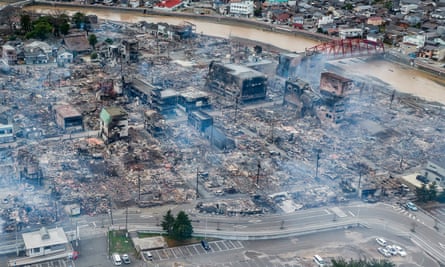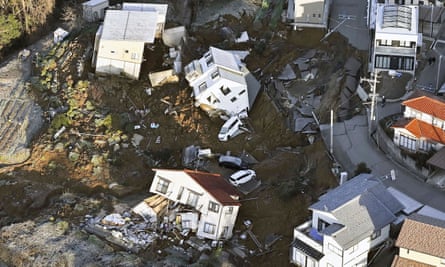Japan’s prime minister has said the country is facing a “battle against time” to rescue those affected by a series of major earthquakes which reportedly killed at least 48 people, injured dozens and sparked fires that destroyed homes.
Police and local authorities early on Tuesday reported cases of bodies being pulled from the rubble of collapsed buildings while others remained trapped.
“We must rescue them as quickly as possible, especially those who are trapped under collapsed structures,” Fumio Kishida said during an emergency disaster meeting.
One thousand army personnel have been dispatched to the worst-hit area in the country’s relatively remote Noto peninsula, but rescue operations have been hindered by badly damaged and blocked roads and one of the area’s airports has been forced to close due to runway cracks.

In Wajima city, fires were still burning at 7am local time on Tuesday and the fire department reports more than 100 homes and other buildings have been completely destroyed. At least 15 of the dead were in Wajima city, the the Kyodo news agency said.
The worst-affected area was around the Asachi-dori street, a district popular with visitors and known for its many wooden buildings. The cause and casualty numbers were currently unclear.
The quakes, the largest of which had a magnitude of 7.6 at a shallow depth of 10km, struck on the west coast of Japan’s main island on Monday and shook buildings in Tokyo, around 300km away.
The epicentre of the quake was on the peninsula, which protrudes into the Sea of Japan, and the loss of life and injuries have been concentrated there. A woman in her fifties was confirmed dead in Nanao city, where more than 30 people were taken to hospital. Other residents of the area were reported to have been found unconscious or believed to be trapped under rubble or missing.

Aftershocks could slam the affected areas over the next few days, the meteorological agency said, and residents of coastal areas were being told not to return to their homes, despite tsunami warnings being lifted.
Japanese public broadcaster NHK TV initially warned that torrents of water could reach as high as five metres and people were evacuated to sports halls, schools and other public buildings.
Bullet trains and flights in and out of the region were all suspended Tuesday morning. Section of major highways remained closed and water supplies were cut due to burst pipes in some areas, according to NHK. Mobile phone networks in the region were also damaged but service was gradually being restored.
British prime minister Rishi Sunak said the UK stood ready to support Japan and that “British nationals in the affected areas should follow the advice of the Japanese authorities.”
The US president, Joe Biden, said in a statement that his administration was in touch with Japanese officials and “ready to provide any necessary assistance for the Japanese people.”
Japan is the most quake-prone nation in the world but a tsunami warning of the magnitude of Monday’s had not been issued since a major quake and tsunami struck the north-east of the country on 11 March 2011, killing 18,000 people. The disaster devastated towns and triggered nuclear meltdowns at the Fukushima Daiichi plant. Nearly all of Japan’s nuclear power plants have been mothballed since the disaster.
Nuclear regulators said no rises in radiation levels were detected at the monitoring posts in the region, and no abnormalities had been detected at the more than 20 reactors situated along the nearby coastline.
https://news.google.com/rss/articles/CBMif2h0dHBzOi8vd3d3LnRoZWd1YXJkaWFuLmNvbS93b3JsZC8yMDI0L2phbi8wMi9qYXBhbi1lYXJ0aHF1YWtlcy10c3VuYW1pLWFsZXJ0LWRyb3BwZWQtYnV0LXJlc2lkZW50cy10b2xkLW5vdC10by1yZXR1cm4tdG8taG9tZXPSAQA?oc=5
2024-01-02 08:38:00Z
CBMif2h0dHBzOi8vd3d3LnRoZWd1YXJkaWFuLmNvbS93b3JsZC8yMDI0L2phbi8wMi9qYXBhbi1lYXJ0aHF1YWtlcy10c3VuYW1pLWFsZXJ0LWRyb3BwZWQtYnV0LXJlc2lkZW50cy10b2xkLW5vdC10by1yZXR1cm4tdG8taG9tZXPSAQA
Tidak ada komentar:
Posting Komentar